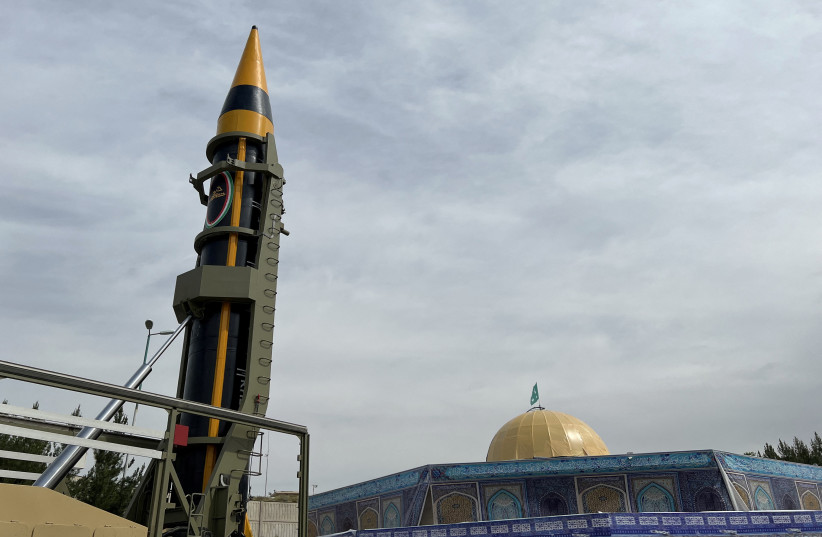Iran on Wednesday announced that it has the technology to build supersonic cruise missiles, leading to some wondering if Israel, and even some US Middle East interests, might now be in greater danger.
Before dissecting what exactly the Islamic Republic really presented and how game-changing or not it is, the first thing we need to notice is that the key phrase here is “cruise missile” as opposed to “supersonic.”
Supersonic is about reaching mach one, something a large number of missiles have been able to do for many decades.
In terms of speech, supersonic is not all that special, and the new goal in threatening adversaries with speed is “hypersonic,” or reaching above mach five.
The cruise missile part, combined with supersonic speed is what is more threatening.
Since the 1990s, Iran has had ballistic missiles which could strike Israel, its Sunni Middle Eastern rivals, and parts of Eastern Europe.
Because of that, Israel has worked hard to develop anti-ballistic missile air defense systems, most prominently the series of Arrow defense systems, the latest of which is the Arrow 3.
Similarly, the US has worked hard to defend against ballistic missile attacks from the USSR in the past, and potentially Russia, China, or North Korea in the present.

Ballistic vs. cruise missiles
In simple terms, ballistic missiles fly on an arc into the earth’s atmosphere before they come back down to strike their target.
This means that much of the US and Israeli radar is focused on looking up for getting hit from above.
In contrast, cruise missiles fly much lower down and have a straighter and shorter flight path to their target.
Cruise missiles can also be launched from ships at sea, presenting an additional kind of threat.
Tehran has for some time had cruise missiles, but until now they were subsonic (slower than mach one) and shorter range. This meant they were less likely to reach Israel and would be easier to defend against – even for Jerusalem’s defenses which were less well-equipped to defend against lower-flying threats.
The question now is whether the ayatollahs have augmented their low-flying threats to be longer-range and fly faster, even as the Jewish state has not exactly focused more energy on defending against cruise missiles in general.
All of this comes at the same time that Iran is trying to develop a hypersonic missile that could not only fly much faster, and be harder to defend against because of speed, but could also maneuver more to outfox standard air defense.
In some ways, the supersonic cruise missile is a threat to Israel more because the IDF is already dividing up its energies in multiple areas to defend against existing threats, and this would be another new threat it would need to address.
Israel does have other layers of air defense besides the Arrow 3, from Iron Dome, to David’s Sling, to using aircraft defensively to shoot down incoming threats.
Some of these layers might be able to stop a supersonic Iranian cruise missile, with David's Sling being the lead candidate.
But primarily these air defense layers were built for shooting down either much slower and shorter-range rockets or for shooting down medium-range ballistic missiles moving along an arc-like trajectory.
So multiple layers of Israel’s air defense might be able to shoot down a supersonic cruise missile, but none of Israel’s many layers were primarily built specifically for that (simply because there were fewer cruise missile-based threats until now.)
And shooting down a supersonic cruise missile would be harder than shooting down slower existing subsonic cruise missiles.
The good news is that the supersonic cruise missile is not yet deployable, but still at testing stages.
Also, Iran’s claims about its missile capabilities are often exaggerated.
Non-democratic countries like Russia, without a free press to hold their heels to the fire, have seen many of their claims about unbeatable missiles burst when they actually had to confront reality, as with Moscow fighting Ukraine.
The same could be true about this latest supersonic cruise missile.
It could just be that the Islamic Republic wanted to make some kind of counter-waves after reports about the arrival of over 3,000 US sailors and Marines on two US ships in the Red Sea to deter Iran from attacking commercial ships in the Strait of Hormuz.
But the bad news is that even back in 2021, Institute for Science and International Security president David Albright put out a report warning that if Iran eventually gets nuclear weapons, it could potentially deliver them not only using land-based ballistic missiles but by ship-fired cruise missiles.
If in fact, Tehran gained this capability, it would be even more threatening to face a nuclear supersonic cruise missile than a nuclear subsonic cruise missile (not that either threat would be taken lightly.)
This means that Israel needs to keep an eye on this latest development and may need to work toward addressing the issue long-term, but that the sky is not falling anytime soon.
